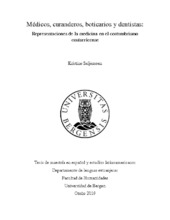| dc.contributor.author | Seljemoen, Kristine Nilsen | |
| dc.date.accessioned | 2019-12-13T03:11:31Z | |
| dc.date.available | 2019-12-13T03:11:31Z | |
| dc.date.issued | 2019-12-13 | |
| dc.date.submitted | 2019-12-12T23:00:07Z | |
| dc.identifier.uri | https://hdl.handle.net/1956/21114 | |
| dc.description.abstract | El objeto principal en este trabajo fue investigar la compleja dinámica que existía entre los tipos de medicina vigentes en la segunda mitad del siglo XIX en Costa Rica vista a través del género literario de los cuadros de costumbres, con énfasis en los discursos que los escritores compartían y reproducían al respeto. Los cuadros de costumbres fueron originalmente publicados en periódicos costarricenses y escritos por letrados de la élite intelectual del país y ofrecen, aparte de valiosas descripciones de los distintos practicantes de la salud —médicos, curanderos, boticarios y dentistas; así como remedios—, una oportunidad para investigar la complicada relación que había entre la medicina convencional y la medicina popular en una manera que no se puede hacer utilizando otros tipos de fuentes. Todos los cuatro cuadros de costumbres que se analizan en esta investigación; “Sea Usted Médico” (1854), “Muletillas” (1890), “Dolor de Muelas” (1893) y “Personas Serviciales” (1900), contienen crítica hacia la medicina popular; pero más importante, tenían una función en la lucha por las reformas liberales que los letrados opinaban fueron necesarias para promover el progreso, la modernización y el desarrollo de una joven nación que en aquella época se encontraba en formación. A pesar de que hay un patrón de rivalidad entre la medicina convencional y la medicina popular, resulta que estos dos campos principales, en apariencia opuestos, en realidad convivían en Costa Rica durante la segunda mitad del siglo XIX. | en_US |
| dc.description.abstract | The main purpose of this work was to investigate the complex dynamic that existed between the different medical practices active in the second half of the nineteenth century in Costa Rica; seen through the literary genre of sketches of manner with emphasis on the discourses which the writers shared and reproduced about the subject. The sketches of manner were originally published in Costa Rican newspapers and written by literates of the country's intellectual elite. Apart from valuable descriptions of the different health practitioners – such as doctors, healers, apothecaries and dentists; as well as remedies — they offer an opportunity to investigate the complicated relationship between conventional medicine and popular medicine in a way that cannot be done using other sources. All four of the sketches of manner that are analyzed in this investigation; "Sea Usted Médico" (1854), "Muletillas" (1890), "Dolor de muelas" (1893), and "Personas serviciales" (1900), contain criticism of popular medicine; but more importantly, they had a role in the fight for liberal reforms that the literates believed were necessary in order to promote progress, modernization and development in a young nation´s formative years. Although there is a pattern of rivalry between conventional medicine and popular medicine, it turns out that these two seemingly opposing fields actually coexisted in Costa Rica during the second half of the nineteenth century. | en_US |
| dc.language.iso | spa | |
| dc.publisher | The University of Bergen | |
| dc.rights | Copyright the Author. All rights reserved | |
| dc.subject | Costumbrismo | |
| dc.subject | Cuadros de costumbres | |
| dc.title | Médicos, curanderos, boticarios y dentistas: Representaciones de la medicina en el costumbrismo costarricense | |
| dc.type | Master thesis | |
| dc.date.updated | 2019-12-12T23:00:07Z | |
| dc.rights.holder | Copyright the Author. All rights reserved | |
| dc.description.degree | Mastergradsoppgave i spansk og latinamerikastudier | |
| dc.description.localcode | MAHF-SPLA | |
| dc.description.localcode | MAHF-LÆFR | |
| dc.description.localcode | SPLA350 | |
| dc.subject.nus | 711128 | |
| fs.subjectcode | SPLA350 | |
| fs.unitcode | 11-20-0 | |
